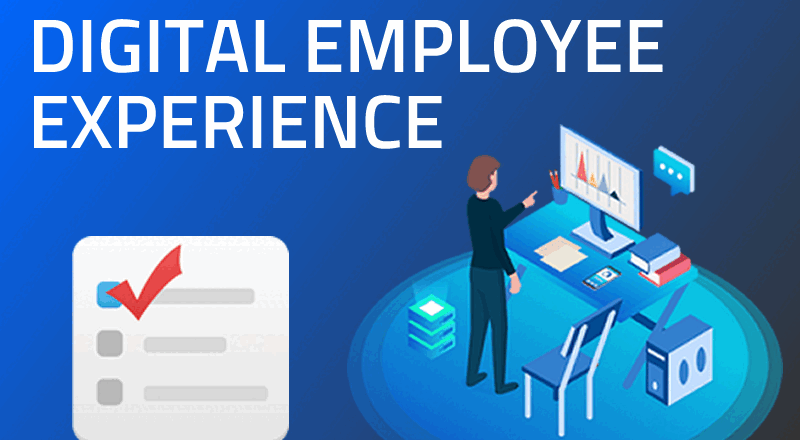
What is Digital Employee Experience?
Digital Employee Experience (DEX) refers to the quality of interactions employees have with the digital tools and technologies provided by their organization. It encompasses everything from the usability of software applications to the efficiency of communication platforms and the accessibility of digital resources. Essentially, DEX is about ensuring that employees have a seamless, productive, and engaging experience with the technology they use daily.
Key Components of DEX
-
User Interface (UI) and User Experience (UX):
- The design and functionality of digital tools should be intuitive and user-friendly. A well-designed UI/UX can significantly enhance employee satisfaction and productivity.
-
Communication and Collaboration Tools:
- Platforms like Microsoft Teams, Slack, and Zoom facilitate seamless communication and collaboration, whether employees are working remotely or in the office.
- Dynamics: Remote work relies heavily on digital communication tools like Microsoft Teams, Slack, and Zoom. These tools become the primary means of interaction, replacing face-to-face meetings and casual office conversations
.
- Impact: Effective use of these tools can enhance collaboration and maintain team cohesion. However, challenges such as communication barriers and the lack of non-verbal cues can lead to misunderstandings and reduced team synergy
-
Productivity Tools:
- Tools such as Asana, Trello, and ClickUp help streamline workflows and improve project management, making it easier for employees to stay organized and efficient.
- Dynamics: Ensuring that all employees have access to the necessary digital tools and resources is crucial for maintaining productivity in a remote work environment
.
- Impact: Providing robust IT support and ensuring that tools are user-friendly and accessible can help employees work efficiently from any location.
-
Learning and Development Platforms:
- Providing access to online training and development resources helps employees upskill and grow within the organization.
-
HR and IT Self-Service Portals:
- Systems like Workday and Paylocity allow employees to manage their HR and IT needs independently, reducing the burden on support teams and empowering employees.
The dynamics of DEX are multifaceted and require a strategic approach to ensure that digital tools and technologies enhance the overall employee experience. By focusing on UI/UX, communication, productivity, learning, self-service, security, accessibility, and continuous improvement, businesses can create a more engaging and productive digital environment for their employees.
Why is DEX Important for Businesses?
-
Enhanced Productivity:
- A positive digital experience enables employees to work more efficiently, reducing downtime and frustration caused by technical issues. This leads to higher productivity and better overall performance.
-
Employee Engagement and Retention:
- When employees have access to effective digital tools, they are more likely to feel engaged and satisfied with their work. This can lead to higher retention rates, as employees are less likely to leave an organization that provides a supportive and efficient digital environment.
- Dynamics: Remote work can lead to feelings of isolation and disconnection from the team and company culture.
- Impact: Organizations need to implement strategies to keep employees engaged, such as virtual team-building activities, regular check-ins, and fostering a strong virtual culture.
-
Improved Customer Experience:
- Happy and productive employees are better equipped to provide excellent customer service. A good DEX can lead to improved customer satisfaction and loyalty, ultimately driving business success.
-
Competitive Advantage:
- Organizations that prioritize DEX are more likely to attract top talent and stay ahead of the competition. In a world where remote and hybrid work is becoming the norm, having a robust digital infrastructure is crucial for business success.
-
Cost Savings:
- Efficient digital tools can reduce the need for extensive IT support and minimize downtime, leading to significant cost savings for the organization.
Improving Digital Employee Experience (DEX) can be a complex task due to several challenges. Here are some of the key obstacles businesses might face:
-
Integration of Diverse Tools
- Challenge: Many organizations use a variety of digital tools and platforms, which can lead to integration issues.
- Solution: Implementing a unified digital workspace or choosing tools that easily integrate with each other can help streamline processes.
-
User Adoption and Training
- Challenge: Employees may resist new technologies or lack the necessary skills to use them effectively.
- Solution: Providing comprehensive training and ongoing support can help employees feel more comfortable and confident with new tools.
-
Maintaining Security and Compliance
- Challenge: Ensuring that digital tools comply with security standards and regulations can be difficult, especially with remote work.
- Solution: Regularly updating security protocols and conducting compliance audits can help mitigate risks.
- Dynamics: Remote work introduces new security challenges, as employees access company systems and data from various locations and devices.
- Impact: Organizations must implement robust security measures, such as VPNs, multi-factor authentication, and regular security training, to protect sensitive information and maintain compliance.
-
Balancing Customization and Standardization
- Challenge: While customization can enhance user experience, it can also lead to inconsistencies and increased complexity.
- Solution: Striking a balance between customization and standardization ensures a consistent and manageable digital environment.
-
Measuring and Analyzing DEX
- Challenge: Quantifying the impact of DEX initiatives can be challenging without the right metrics and tools.
- Solution: Implementing analytics tools and regularly collecting feedback from employees can provide valuable insights into the effectiveness of DEX strategies.
- Dynamics: Managing and evaluating employee performance remotely can be challenging without the ability to observe daily work habits and interactions.
- Impact: Clear performance metrics, regular feedback, and transparent communication are essential to ensure accountability and support employee development in a remote setting.
-
Keeping Up with Technological Advancements
- Challenge: The rapid pace of technological change can make it difficult for organizations to stay current.
- Solution: Staying informed about industry trends and being flexible in adopting new technologies can help businesses remain competitive.
-
Ensuring Accessibility
- Challenge: Ensuring that digital tools are accessible to all employees, including those with disabilities, can be challenging.
- Solution: Adopting inclusive design principles and regularly testing tools for accessibility can help create a more inclusive digital environment.
-
Managing Costs
- Challenge: Investing in new technologies and maintaining existing ones can be costly.
- Solution: Prioritizing investments based on their potential impact on DEX and seeking cost-effective solutions can help manage expenses.
Conclusion
Investing in Digital Employee Experience is no longer optional for businesses that want to thrive in the digital age. By providing employees with the right tools and technologies, organizations can enhance productivity, improve employee engagement, and deliver better customer experiences. Improving DEX requires a strategic approach that addresses these challenges while keeping the needs of employees at the forefront. Ultimately, a strong DEX strategy can drive business success and provide a competitive edge in today's dynamic market.
Get in touch with FUSION 1 to learn more about digital employee experience solutions for your business.

